Exploring Religion, Animal Rights, and Governance in Australia
VerifiedAdded on 2023/04/25
|10
|2820
|308
Essay
AI Summary
This essay delves into the multifaceted issue of animal slaughter in Australia, examining its intersection with religious practices, animal rights, and governmental responsibilities. It explores the increasing instances of animal slaughter, particularly within the context of Halal meat and the perspectives of Muslim and Jewish faiths. The essay highlights the rising trend of veganism and its impact on societal views, attributing its growth to increased awareness of animal welfare and the influence of social media. It also discusses the responsibilities of individuals, communities, and the government in protecting animal rights and promoting ethical treatment. The essay analyzes the legal frameworks and legislation in place, such as the Prevention of Cruelty to Animals Act, and suggests the need for stricter implementation and campaigns to address the issue of animal cruelty. Ultimately, the essay concludes by emphasizing the need for a balanced approach that respects both religious beliefs and animal welfare to secure the environment and ecosystem.
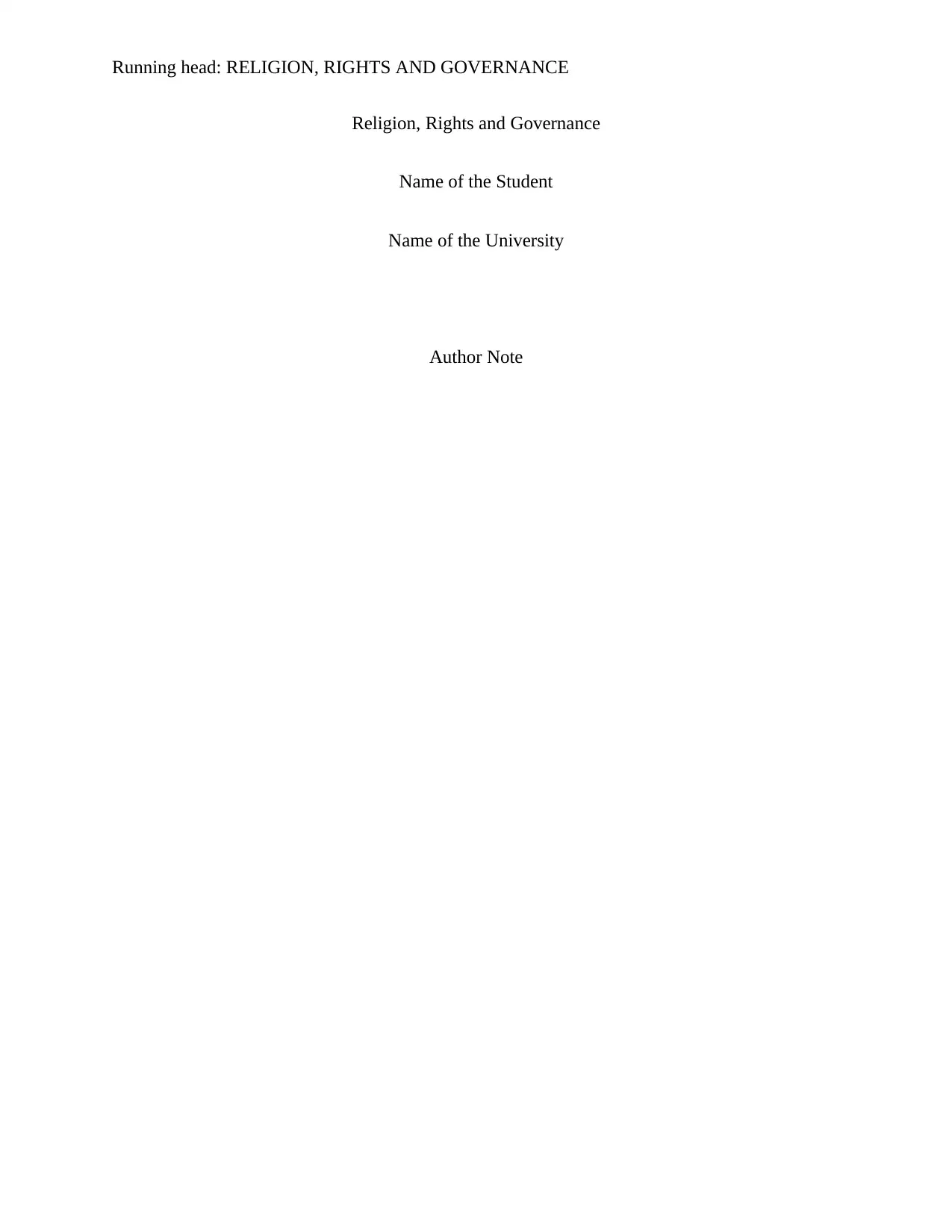
Running head: RELIGION, RIGHTS AND GOVERNANCE
Religion, Rights and Governance
Name of the Student
Name of the University
Author Note
Religion, Rights and Governance
Name of the Student
Name of the University
Author Note
Paraphrase This Document
Need a fresh take? Get an instant paraphrase of this document with our AI Paraphraser
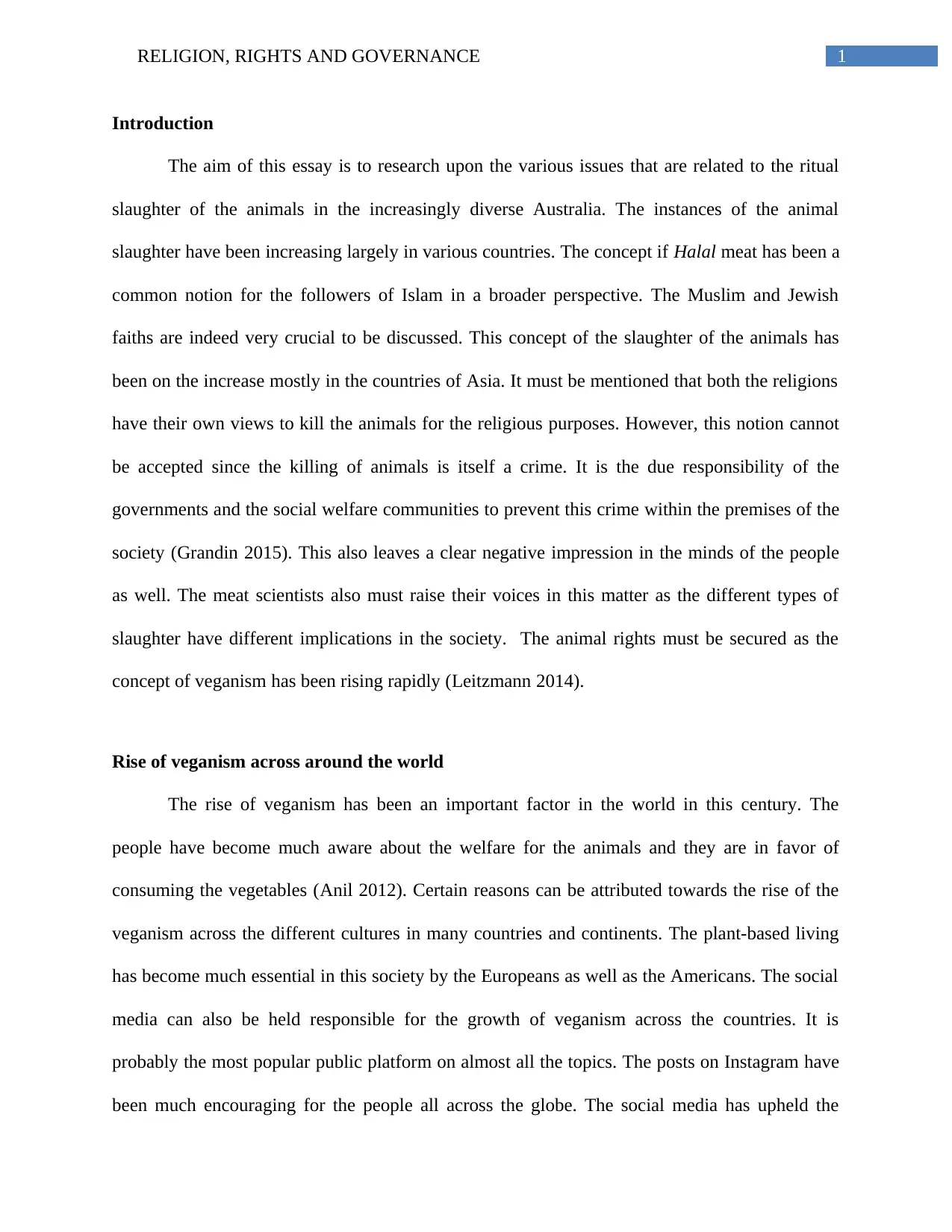
1RELIGION, RIGHTS AND GOVERNANCE
Introduction
The aim of this essay is to research upon the various issues that are related to the ritual
slaughter of the animals in the increasingly diverse Australia. The instances of the animal
slaughter have been increasing largely in various countries. The concept if Halal meat has been a
common notion for the followers of Islam in a broader perspective. The Muslim and Jewish
faiths are indeed very crucial to be discussed. This concept of the slaughter of the animals has
been on the increase mostly in the countries of Asia. It must be mentioned that both the religions
have their own views to kill the animals for the religious purposes. However, this notion cannot
be accepted since the killing of animals is itself a crime. It is the due responsibility of the
governments and the social welfare communities to prevent this crime within the premises of the
society (Grandin 2015). This also leaves a clear negative impression in the minds of the people
as well. The meat scientists also must raise their voices in this matter as the different types of
slaughter have different implications in the society. The animal rights must be secured as the
concept of veganism has been rising rapidly (Leitzmann 2014).
Rise of veganism across around the world
The rise of veganism has been an important factor in the world in this century. The
people have become much aware about the welfare for the animals and they are in favor of
consuming the vegetables (Anil 2012). Certain reasons can be attributed towards the rise of the
veganism across the different cultures in many countries and continents. The plant-based living
has become much essential in this society by the Europeans as well as the Americans. The social
media can also be held responsible for the growth of veganism across the countries. It is
probably the most popular public platform on almost all the topics. The posts on Instagram have
been much encouraging for the people all across the globe. The social media has upheld the
Introduction
The aim of this essay is to research upon the various issues that are related to the ritual
slaughter of the animals in the increasingly diverse Australia. The instances of the animal
slaughter have been increasing largely in various countries. The concept if Halal meat has been a
common notion for the followers of Islam in a broader perspective. The Muslim and Jewish
faiths are indeed very crucial to be discussed. This concept of the slaughter of the animals has
been on the increase mostly in the countries of Asia. It must be mentioned that both the religions
have their own views to kill the animals for the religious purposes. However, this notion cannot
be accepted since the killing of animals is itself a crime. It is the due responsibility of the
governments and the social welfare communities to prevent this crime within the premises of the
society (Grandin 2015). This also leaves a clear negative impression in the minds of the people
as well. The meat scientists also must raise their voices in this matter as the different types of
slaughter have different implications in the society. The animal rights must be secured as the
concept of veganism has been rising rapidly (Leitzmann 2014).
Rise of veganism across around the world
The rise of veganism has been an important factor in the world in this century. The
people have become much aware about the welfare for the animals and they are in favor of
consuming the vegetables (Anil 2012). Certain reasons can be attributed towards the rise of the
veganism across the different cultures in many countries and continents. The plant-based living
has become much essential in this society by the Europeans as well as the Americans. The social
media can also be held responsible for the growth of veganism across the countries. It is
probably the most popular public platform on almost all the topics. The posts on Instagram have
been much encouraging for the people all across the globe. The social media has upheld the
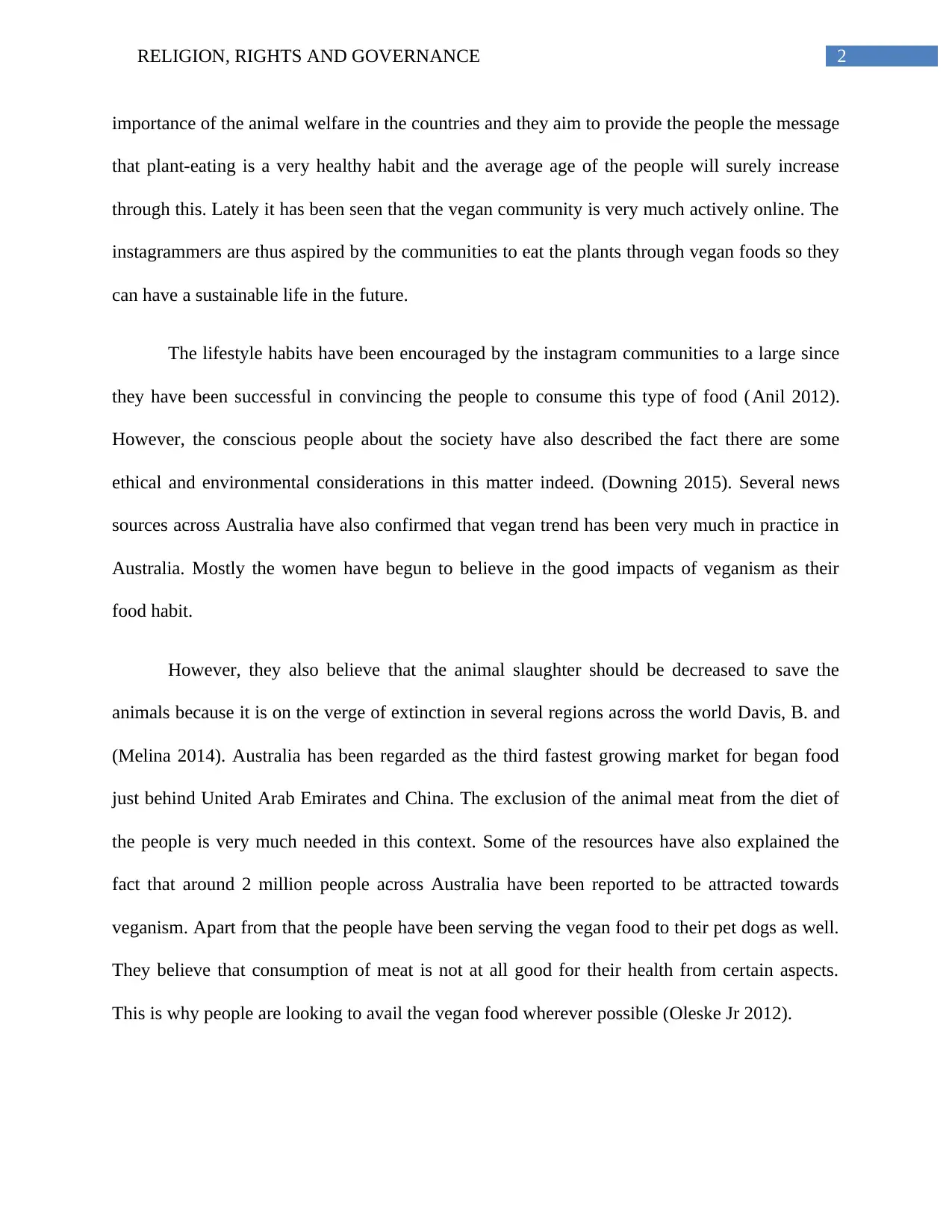
2RELIGION, RIGHTS AND GOVERNANCE
importance of the animal welfare in the countries and they aim to provide the people the message
that plant-eating is a very healthy habit and the average age of the people will surely increase
through this. Lately it has been seen that the vegan community is very much actively online. The
instagrammers are thus aspired by the communities to eat the plants through vegan foods so they
can have a sustainable life in the future.
The lifestyle habits have been encouraged by the instagram communities to a large since
they have been successful in convincing the people to consume this type of food (Anil 2012).
However, the conscious people about the society have also described the fact there are some
ethical and environmental considerations in this matter indeed. (Downing 2015). Several news
sources across Australia have also confirmed that vegan trend has been very much in practice in
Australia. Mostly the women have begun to believe in the good impacts of veganism as their
food habit.
However, they also believe that the animal slaughter should be decreased to save the
animals because it is on the verge of extinction in several regions across the world Davis, B. and
(Melina 2014). Australia has been regarded as the third fastest growing market for began food
just behind United Arab Emirates and China. The exclusion of the animal meat from the diet of
the people is very much needed in this context. Some of the resources have also explained the
fact that around 2 million people across Australia have been reported to be attracted towards
veganism. Apart from that the people have been serving the vegan food to their pet dogs as well.
They believe that consumption of meat is not at all good for their health from certain aspects.
This is why people are looking to avail the vegan food wherever possible (Oleske Jr 2012).
importance of the animal welfare in the countries and they aim to provide the people the message
that plant-eating is a very healthy habit and the average age of the people will surely increase
through this. Lately it has been seen that the vegan community is very much actively online. The
instagrammers are thus aspired by the communities to eat the plants through vegan foods so they
can have a sustainable life in the future.
The lifestyle habits have been encouraged by the instagram communities to a large since
they have been successful in convincing the people to consume this type of food (Anil 2012).
However, the conscious people about the society have also described the fact there are some
ethical and environmental considerations in this matter indeed. (Downing 2015). Several news
sources across Australia have also confirmed that vegan trend has been very much in practice in
Australia. Mostly the women have begun to believe in the good impacts of veganism as their
food habit.
However, they also believe that the animal slaughter should be decreased to save the
animals because it is on the verge of extinction in several regions across the world Davis, B. and
(Melina 2014). Australia has been regarded as the third fastest growing market for began food
just behind United Arab Emirates and China. The exclusion of the animal meat from the diet of
the people is very much needed in this context. Some of the resources have also explained the
fact that around 2 million people across Australia have been reported to be attracted towards
veganism. Apart from that the people have been serving the vegan food to their pet dogs as well.
They believe that consumption of meat is not at all good for their health from certain aspects.
This is why people are looking to avail the vegan food wherever possible (Oleske Jr 2012).
⊘ This is a preview!⊘
Do you want full access?
Subscribe today to unlock all pages.

Trusted by 1+ million students worldwide
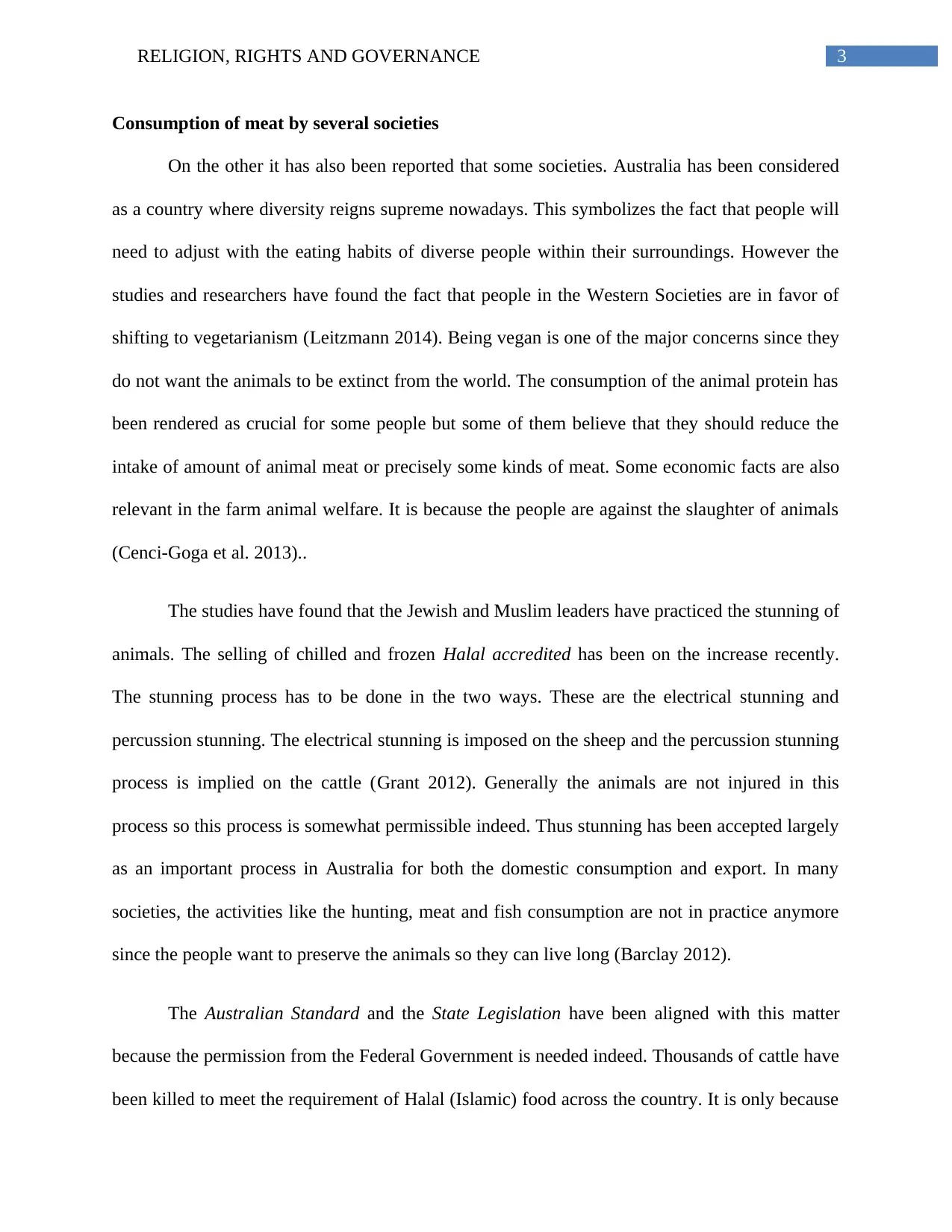
3RELIGION, RIGHTS AND GOVERNANCE
Consumption of meat by several societies
On the other it has also been reported that some societies. Australia has been considered
as a country where diversity reigns supreme nowadays. This symbolizes the fact that people will
need to adjust with the eating habits of diverse people within their surroundings. However the
studies and researchers have found the fact that people in the Western Societies are in favor of
shifting to vegetarianism (Leitzmann 2014). Being vegan is one of the major concerns since they
do not want the animals to be extinct from the world. The consumption of the animal protein has
been rendered as crucial for some people but some of them believe that they should reduce the
intake of amount of animal meat or precisely some kinds of meat. Some economic facts are also
relevant in the farm animal welfare. It is because the people are against the slaughter of animals
(Cenci-Goga et al. 2013)..
The studies have found that the Jewish and Muslim leaders have practiced the stunning of
animals. The selling of chilled and frozen Halal accredited has been on the increase recently.
The stunning process has to be done in the two ways. These are the electrical stunning and
percussion stunning. The electrical stunning is imposed on the sheep and the percussion stunning
process is implied on the cattle (Grant 2012). Generally the animals are not injured in this
process so this process is somewhat permissible indeed. Thus stunning has been accepted largely
as an important process in Australia for both the domestic consumption and export. In many
societies, the activities like the hunting, meat and fish consumption are not in practice anymore
since the people want to preserve the animals so they can live long (Barclay 2012).
The Australian Standard and the State Legislation have been aligned with this matter
because the permission from the Federal Government is needed indeed. Thousands of cattle have
been killed to meet the requirement of Halal (Islamic) food across the country. It is only because
Consumption of meat by several societies
On the other it has also been reported that some societies. Australia has been considered
as a country where diversity reigns supreme nowadays. This symbolizes the fact that people will
need to adjust with the eating habits of diverse people within their surroundings. However the
studies and researchers have found the fact that people in the Western Societies are in favor of
shifting to vegetarianism (Leitzmann 2014). Being vegan is one of the major concerns since they
do not want the animals to be extinct from the world. The consumption of the animal protein has
been rendered as crucial for some people but some of them believe that they should reduce the
intake of amount of animal meat or precisely some kinds of meat. Some economic facts are also
relevant in the farm animal welfare. It is because the people are against the slaughter of animals
(Cenci-Goga et al. 2013)..
The studies have found that the Jewish and Muslim leaders have practiced the stunning of
animals. The selling of chilled and frozen Halal accredited has been on the increase recently.
The stunning process has to be done in the two ways. These are the electrical stunning and
percussion stunning. The electrical stunning is imposed on the sheep and the percussion stunning
process is implied on the cattle (Grant 2012). Generally the animals are not injured in this
process so this process is somewhat permissible indeed. Thus stunning has been accepted largely
as an important process in Australia for both the domestic consumption and export. In many
societies, the activities like the hunting, meat and fish consumption are not in practice anymore
since the people want to preserve the animals so they can live long (Barclay 2012).
The Australian Standard and the State Legislation have been aligned with this matter
because the permission from the Federal Government is needed indeed. Thousands of cattle have
been killed to meet the requirement of Halal (Islamic) food across the country. It is only because
Paraphrase This Document
Need a fresh take? Get an instant paraphrase of this document with our AI Paraphraser
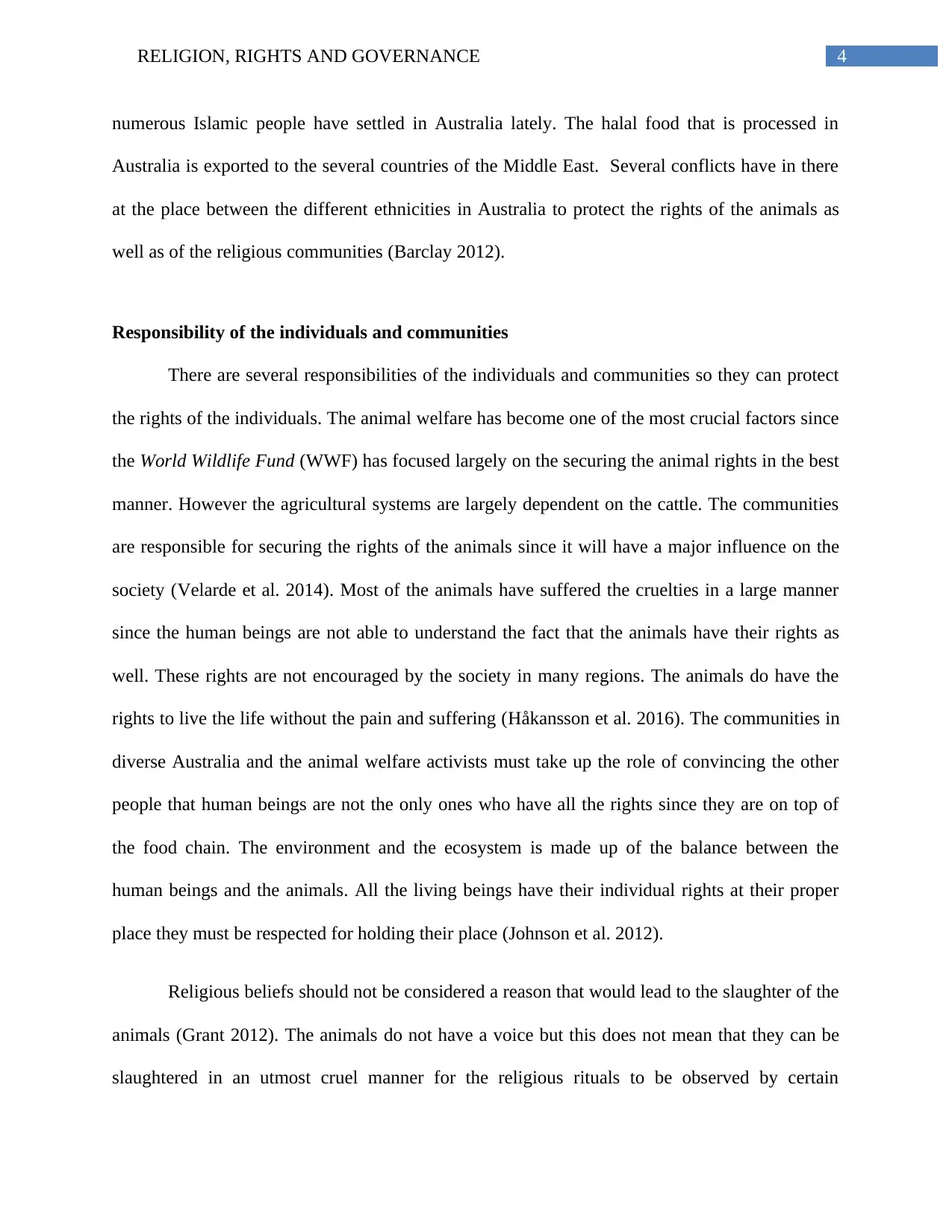
4RELIGION, RIGHTS AND GOVERNANCE
numerous Islamic people have settled in Australia lately. The halal food that is processed in
Australia is exported to the several countries of the Middle East. Several conflicts have in there
at the place between the different ethnicities in Australia to protect the rights of the animals as
well as of the religious communities (Barclay 2012).
Responsibility of the individuals and communities
There are several responsibilities of the individuals and communities so they can protect
the rights of the individuals. The animal welfare has become one of the most crucial factors since
the World Wildlife Fund (WWF) has focused largely on the securing the animal rights in the best
manner. However the agricultural systems are largely dependent on the cattle. The communities
are responsible for securing the rights of the animals since it will have a major influence on the
society (Velarde et al. 2014). Most of the animals have suffered the cruelties in a large manner
since the human beings are not able to understand the fact that the animals have their rights as
well. These rights are not encouraged by the society in many regions. The animals do have the
rights to live the life without the pain and suffering (Håkansson et al. 2016). The communities in
diverse Australia and the animal welfare activists must take up the role of convincing the other
people that human beings are not the only ones who have all the rights since they are on top of
the food chain. The environment and the ecosystem is made up of the balance between the
human beings and the animals. All the living beings have their individual rights at their proper
place they must be respected for holding their place (Johnson et al. 2012).
Religious beliefs should not be considered a reason that would lead to the slaughter of the
animals (Grant 2012). The animals do not have a voice but this does not mean that they can be
slaughtered in an utmost cruel manner for the religious rituals to be observed by certain
numerous Islamic people have settled in Australia lately. The halal food that is processed in
Australia is exported to the several countries of the Middle East. Several conflicts have in there
at the place between the different ethnicities in Australia to protect the rights of the animals as
well as of the religious communities (Barclay 2012).
Responsibility of the individuals and communities
There are several responsibilities of the individuals and communities so they can protect
the rights of the individuals. The animal welfare has become one of the most crucial factors since
the World Wildlife Fund (WWF) has focused largely on the securing the animal rights in the best
manner. However the agricultural systems are largely dependent on the cattle. The communities
are responsible for securing the rights of the animals since it will have a major influence on the
society (Velarde et al. 2014). Most of the animals have suffered the cruelties in a large manner
since the human beings are not able to understand the fact that the animals have their rights as
well. These rights are not encouraged by the society in many regions. The animals do have the
rights to live the life without the pain and suffering (Håkansson et al. 2016). The communities in
diverse Australia and the animal welfare activists must take up the role of convincing the other
people that human beings are not the only ones who have all the rights since they are on top of
the food chain. The environment and the ecosystem is made up of the balance between the
human beings and the animals. All the living beings have their individual rights at their proper
place they must be respected for holding their place (Johnson et al. 2012).
Religious beliefs should not be considered a reason that would lead to the slaughter of the
animals (Grant 2012). The animals do not have a voice but this does not mean that they can be
slaughtered in an utmost cruel manner for the religious rituals to be observed by certain
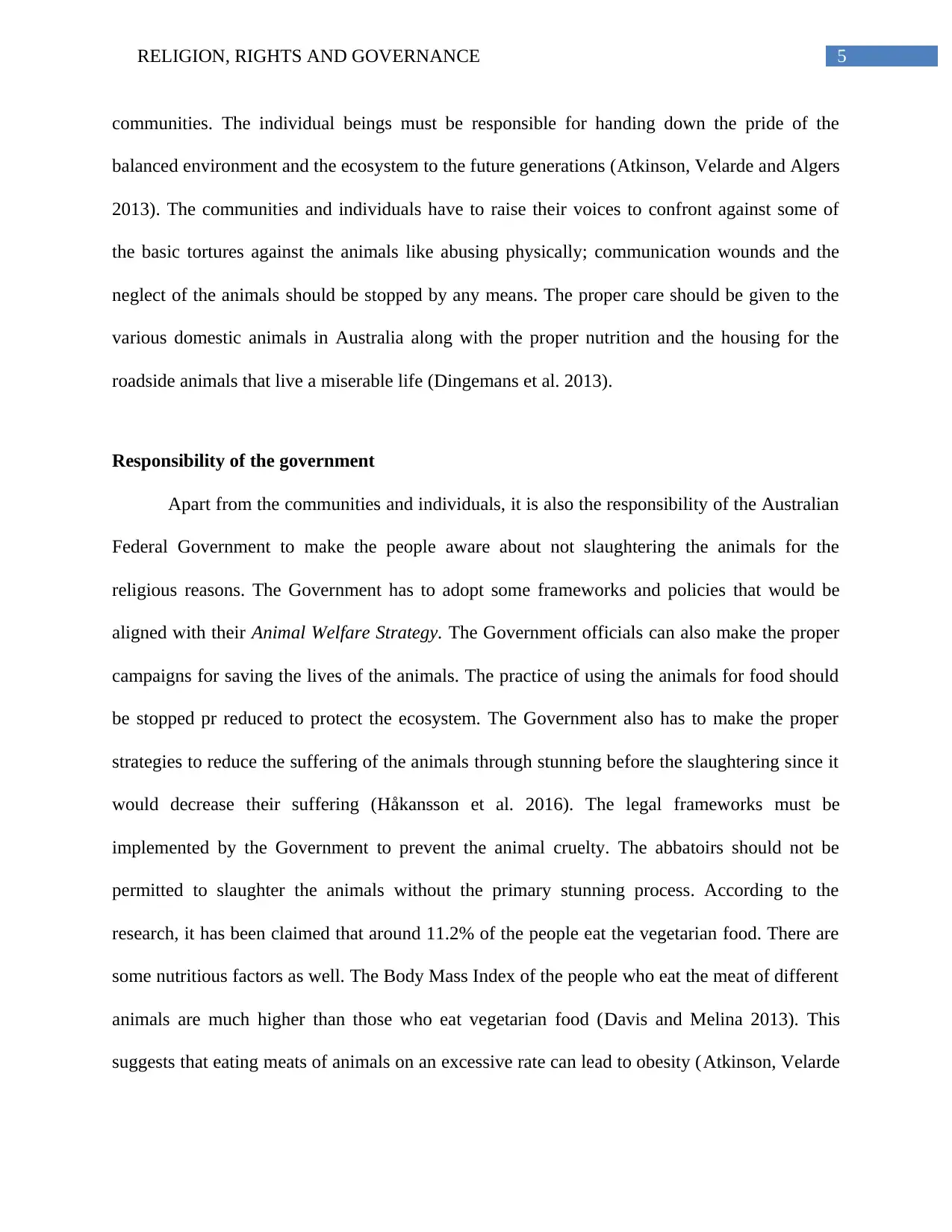
5RELIGION, RIGHTS AND GOVERNANCE
communities. The individual beings must be responsible for handing down the pride of the
balanced environment and the ecosystem to the future generations (Atkinson, Velarde and Algers
2013). The communities and individuals have to raise their voices to confront against some of
the basic tortures against the animals like abusing physically; communication wounds and the
neglect of the animals should be stopped by any means. The proper care should be given to the
various domestic animals in Australia along with the proper nutrition and the housing for the
roadside animals that live a miserable life (Dingemans et al. 2013).
Responsibility of the government
Apart from the communities and individuals, it is also the responsibility of the Australian
Federal Government to make the people aware about not slaughtering the animals for the
religious reasons. The Government has to adopt some frameworks and policies that would be
aligned with their Animal Welfare Strategy. The Government officials can also make the proper
campaigns for saving the lives of the animals. The practice of using the animals for food should
be stopped pr reduced to protect the ecosystem. The Government also has to make the proper
strategies to reduce the suffering of the animals through stunning before the slaughtering since it
would decrease their suffering (Håkansson et al. 2016). The legal frameworks must be
implemented by the Government to prevent the animal cruelty. The abbatoirs should not be
permitted to slaughter the animals without the primary stunning process. According to the
research, it has been claimed that around 11.2% of the people eat the vegetarian food. There are
some nutritious factors as well. The Body Mass Index of the people who eat the meat of different
animals are much higher than those who eat vegetarian food (Davis and Melina 2013). This
suggests that eating meats of animals on an excessive rate can lead to obesity (Atkinson, Velarde
communities. The individual beings must be responsible for handing down the pride of the
balanced environment and the ecosystem to the future generations (Atkinson, Velarde and Algers
2013). The communities and individuals have to raise their voices to confront against some of
the basic tortures against the animals like abusing physically; communication wounds and the
neglect of the animals should be stopped by any means. The proper care should be given to the
various domestic animals in Australia along with the proper nutrition and the housing for the
roadside animals that live a miserable life (Dingemans et al. 2013).
Responsibility of the government
Apart from the communities and individuals, it is also the responsibility of the Australian
Federal Government to make the people aware about not slaughtering the animals for the
religious reasons. The Government has to adopt some frameworks and policies that would be
aligned with their Animal Welfare Strategy. The Government officials can also make the proper
campaigns for saving the lives of the animals. The practice of using the animals for food should
be stopped pr reduced to protect the ecosystem. The Government also has to make the proper
strategies to reduce the suffering of the animals through stunning before the slaughtering since it
would decrease their suffering (Håkansson et al. 2016). The legal frameworks must be
implemented by the Government to prevent the animal cruelty. The abbatoirs should not be
permitted to slaughter the animals without the primary stunning process. According to the
research, it has been claimed that around 11.2% of the people eat the vegetarian food. There are
some nutritious factors as well. The Body Mass Index of the people who eat the meat of different
animals are much higher than those who eat vegetarian food (Davis and Melina 2013). This
suggests that eating meats of animals on an excessive rate can lead to obesity (Atkinson, Velarde
⊘ This is a preview!⊘
Do you want full access?
Subscribe today to unlock all pages.

Trusted by 1+ million students worldwide
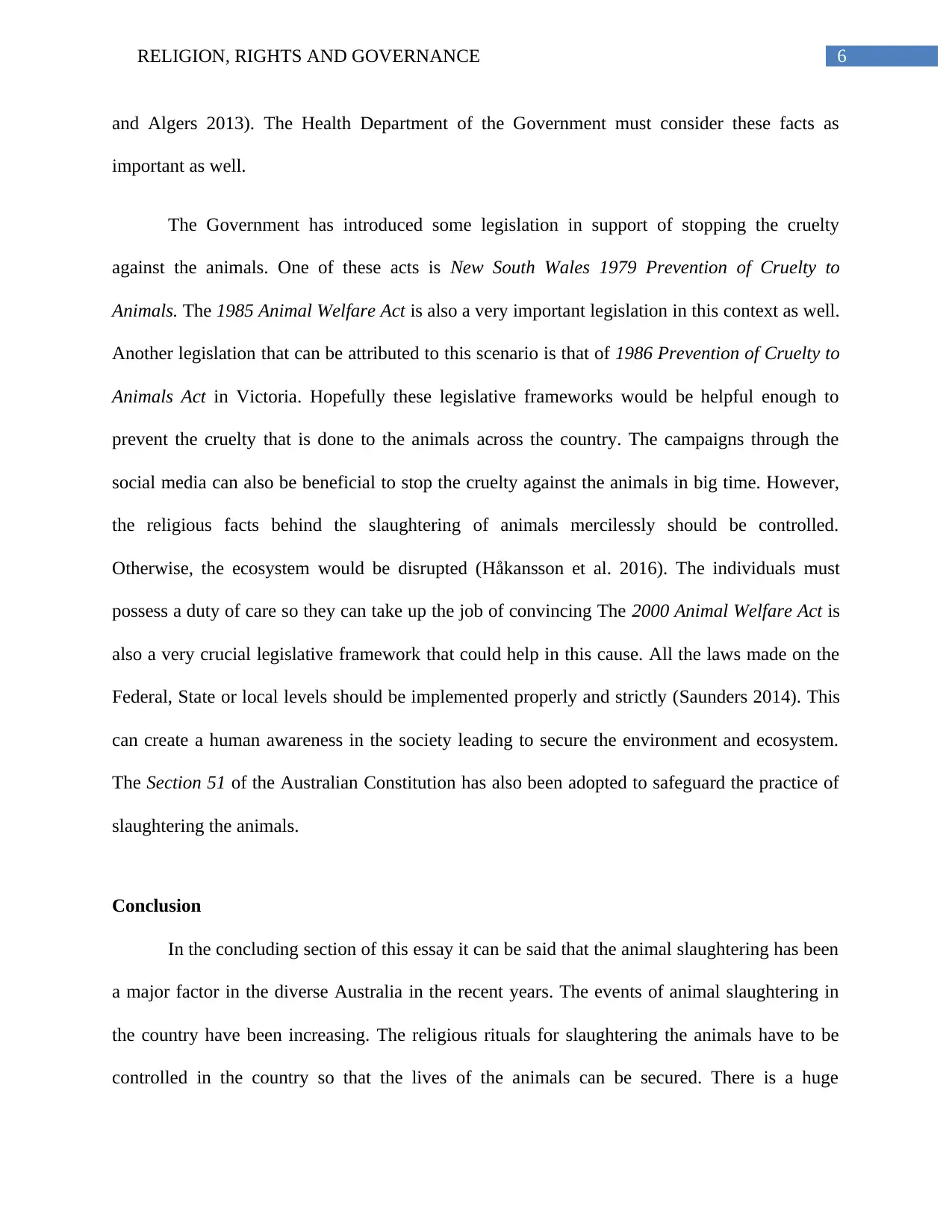
6RELIGION, RIGHTS AND GOVERNANCE
and Algers 2013). The Health Department of the Government must consider these facts as
important as well.
The Government has introduced some legislation in support of stopping the cruelty
against the animals. One of these acts is New South Wales 1979 Prevention of Cruelty to
Animals. The 1985 Animal Welfare Act is also a very important legislation in this context as well.
Another legislation that can be attributed to this scenario is that of 1986 Prevention of Cruelty to
Animals Act in Victoria. Hopefully these legislative frameworks would be helpful enough to
prevent the cruelty that is done to the animals across the country. The campaigns through the
social media can also be beneficial to stop the cruelty against the animals in big time. However,
the religious facts behind the slaughtering of animals mercilessly should be controlled.
Otherwise, the ecosystem would be disrupted (Håkansson et al. 2016). The individuals must
possess a duty of care so they can take up the job of convincing The 2000 Animal Welfare Act is
also a very crucial legislative framework that could help in this cause. All the laws made on the
Federal, State or local levels should be implemented properly and strictly (Saunders 2014). This
can create a human awareness in the society leading to secure the environment and ecosystem.
The Section 51 of the Australian Constitution has also been adopted to safeguard the practice of
slaughtering the animals.
Conclusion
In the concluding section of this essay it can be said that the animal slaughtering has been
a major factor in the diverse Australia in the recent years. The events of animal slaughtering in
the country have been increasing. The religious rituals for slaughtering the animals have to be
controlled in the country so that the lives of the animals can be secured. There is a huge
and Algers 2013). The Health Department of the Government must consider these facts as
important as well.
The Government has introduced some legislation in support of stopping the cruelty
against the animals. One of these acts is New South Wales 1979 Prevention of Cruelty to
Animals. The 1985 Animal Welfare Act is also a very important legislation in this context as well.
Another legislation that can be attributed to this scenario is that of 1986 Prevention of Cruelty to
Animals Act in Victoria. Hopefully these legislative frameworks would be helpful enough to
prevent the cruelty that is done to the animals across the country. The campaigns through the
social media can also be beneficial to stop the cruelty against the animals in big time. However,
the religious facts behind the slaughtering of animals mercilessly should be controlled.
Otherwise, the ecosystem would be disrupted (Håkansson et al. 2016). The individuals must
possess a duty of care so they can take up the job of convincing The 2000 Animal Welfare Act is
also a very crucial legislative framework that could help in this cause. All the laws made on the
Federal, State or local levels should be implemented properly and strictly (Saunders 2014). This
can create a human awareness in the society leading to secure the environment and ecosystem.
The Section 51 of the Australian Constitution has also been adopted to safeguard the practice of
slaughtering the animals.
Conclusion
In the concluding section of this essay it can be said that the animal slaughtering has been
a major factor in the diverse Australia in the recent years. The events of animal slaughtering in
the country have been increasing. The religious rituals for slaughtering the animals have to be
controlled in the country so that the lives of the animals can be secured. There is a huge
Paraphrase This Document
Need a fresh take? Get an instant paraphrase of this document with our AI Paraphraser
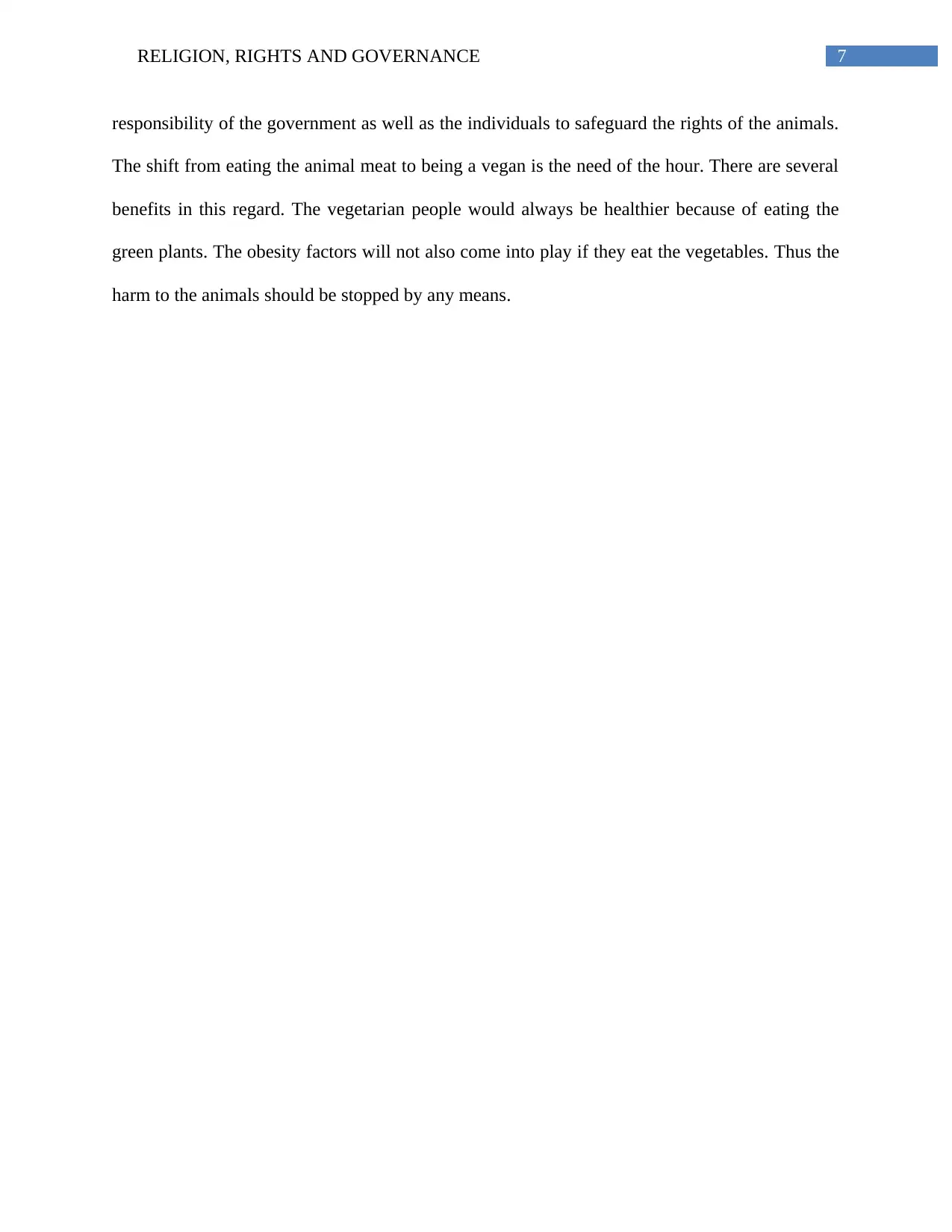
7RELIGION, RIGHTS AND GOVERNANCE
responsibility of the government as well as the individuals to safeguard the rights of the animals.
The shift from eating the animal meat to being a vegan is the need of the hour. There are several
benefits in this regard. The vegetarian people would always be healthier because of eating the
green plants. The obesity factors will not also come into play if they eat the vegetables. Thus the
harm to the animals should be stopped by any means.
responsibility of the government as well as the individuals to safeguard the rights of the animals.
The shift from eating the animal meat to being a vegan is the need of the hour. There are several
benefits in this regard. The vegetarian people would always be healthier because of eating the
green plants. The obesity factors will not also come into play if they eat the vegetables. Thus the
harm to the animals should be stopped by any means.
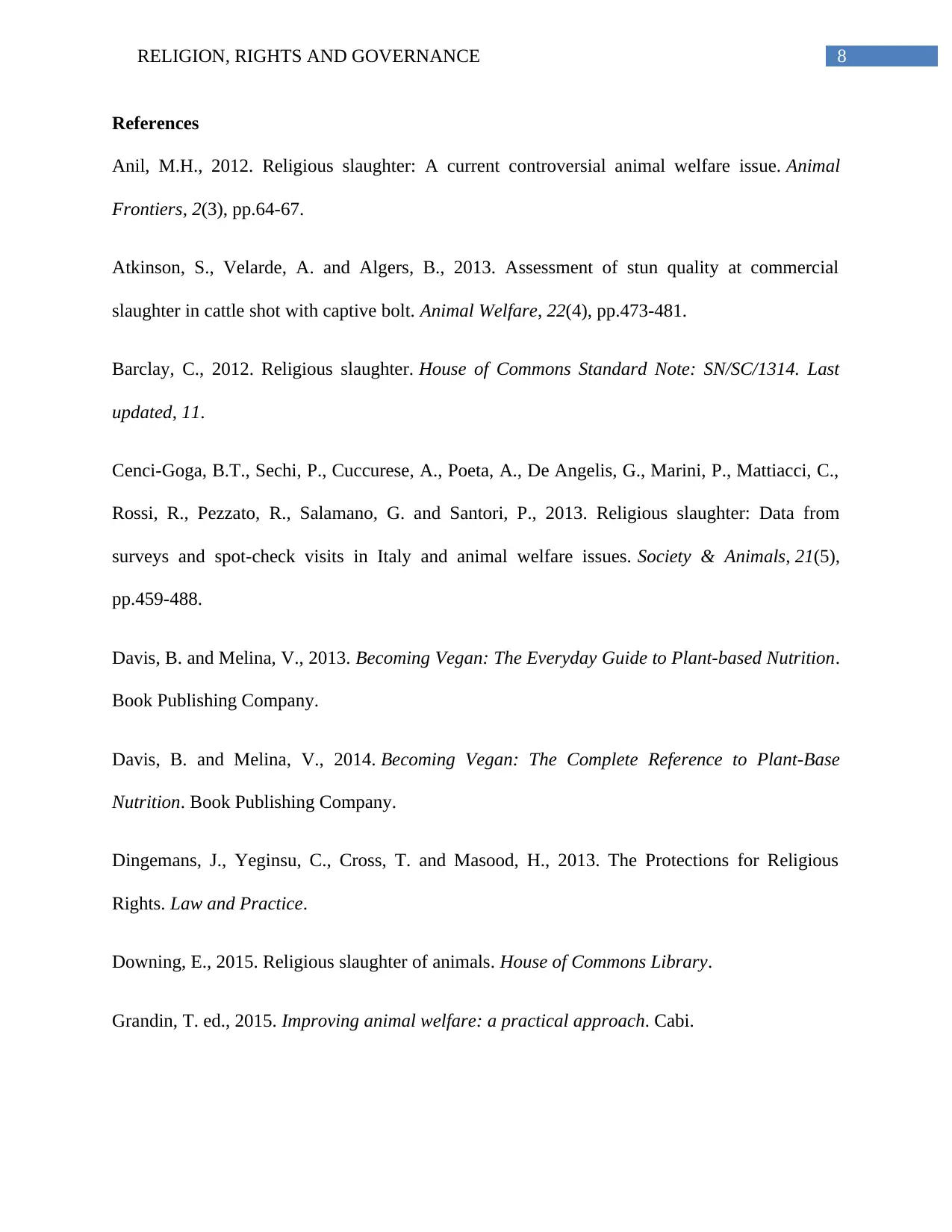
8RELIGION, RIGHTS AND GOVERNANCE
References
Anil, M.H., 2012. Religious slaughter: A current controversial animal welfare issue. Animal
Frontiers, 2(3), pp.64-67.
Atkinson, S., Velarde, A. and Algers, B., 2013. Assessment of stun quality at commercial
slaughter in cattle shot with captive bolt. Animal Welfare, 22(4), pp.473-481.
Barclay, C., 2012. Religious slaughter. House of Commons Standard Note: SN/SC/1314. Last
updated, 11.
Cenci-Goga, B.T., Sechi, P., Cuccurese, A., Poeta, A., De Angelis, G., Marini, P., Mattiacci, C.,
Rossi, R., Pezzato, R., Salamano, G. and Santori, P., 2013. Religious slaughter: Data from
surveys and spot-check visits in Italy and animal welfare issues. Society & Animals, 21(5),
pp.459-488.
Davis, B. and Melina, V., 2013. Becoming Vegan: The Everyday Guide to Plant-based Nutrition.
Book Publishing Company.
Davis, B. and Melina, V., 2014. Becoming Vegan: The Complete Reference to Plant-Base
Nutrition. Book Publishing Company.
Dingemans, J., Yeginsu, C., Cross, T. and Masood, H., 2013. The Protections for Religious
Rights. Law and Practice.
Downing, E., 2015. Religious slaughter of animals. House of Commons Library.
Grandin, T. ed., 2015. Improving animal welfare: a practical approach. Cabi.
References
Anil, M.H., 2012. Religious slaughter: A current controversial animal welfare issue. Animal
Frontiers, 2(3), pp.64-67.
Atkinson, S., Velarde, A. and Algers, B., 2013. Assessment of stun quality at commercial
slaughter in cattle shot with captive bolt. Animal Welfare, 22(4), pp.473-481.
Barclay, C., 2012. Religious slaughter. House of Commons Standard Note: SN/SC/1314. Last
updated, 11.
Cenci-Goga, B.T., Sechi, P., Cuccurese, A., Poeta, A., De Angelis, G., Marini, P., Mattiacci, C.,
Rossi, R., Pezzato, R., Salamano, G. and Santori, P., 2013. Religious slaughter: Data from
surveys and spot-check visits in Italy and animal welfare issues. Society & Animals, 21(5),
pp.459-488.
Davis, B. and Melina, V., 2013. Becoming Vegan: The Everyday Guide to Plant-based Nutrition.
Book Publishing Company.
Davis, B. and Melina, V., 2014. Becoming Vegan: The Complete Reference to Plant-Base
Nutrition. Book Publishing Company.
Dingemans, J., Yeginsu, C., Cross, T. and Masood, H., 2013. The Protections for Religious
Rights. Law and Practice.
Downing, E., 2015. Religious slaughter of animals. House of Commons Library.
Grandin, T. ed., 2015. Improving animal welfare: a practical approach. Cabi.
⊘ This is a preview!⊘
Do you want full access?
Subscribe today to unlock all pages.

Trusted by 1+ million students worldwide
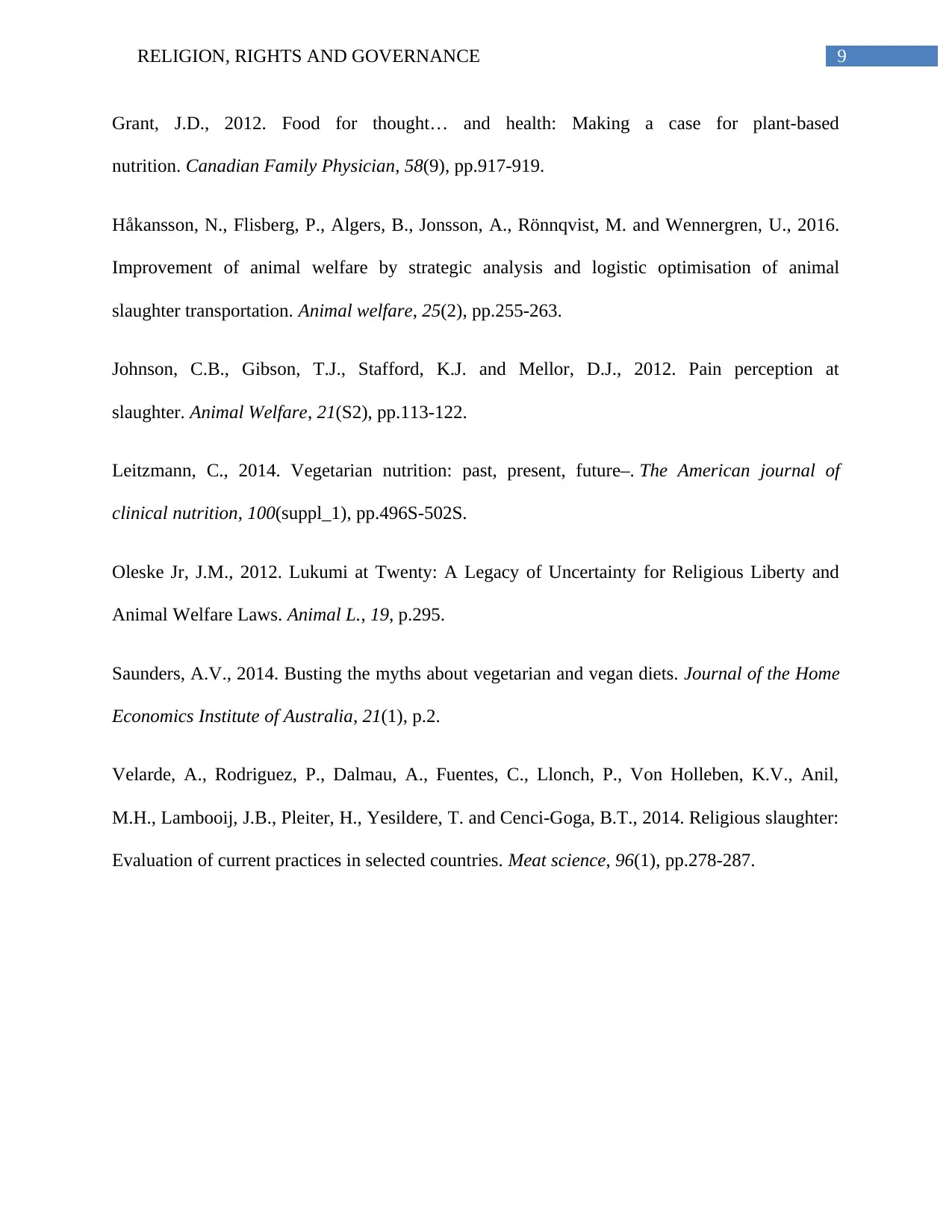
9RELIGION, RIGHTS AND GOVERNANCE
Grant, J.D., 2012. Food for thought… and health: Making a case for plant-based
nutrition. Canadian Family Physician, 58(9), pp.917-919.
Håkansson, N., Flisberg, P., Algers, B., Jonsson, A., Rönnqvist, M. and Wennergren, U., 2016.
Improvement of animal welfare by strategic analysis and logistic optimisation of animal
slaughter transportation. Animal welfare, 25(2), pp.255-263.
Johnson, C.B., Gibson, T.J., Stafford, K.J. and Mellor, D.J., 2012. Pain perception at
slaughter. Animal Welfare, 21(S2), pp.113-122.
Leitzmann, C., 2014. Vegetarian nutrition: past, present, future–. The American journal of
clinical nutrition, 100(suppl_1), pp.496S-502S.
Oleske Jr, J.M., 2012. Lukumi at Twenty: A Legacy of Uncertainty for Religious Liberty and
Animal Welfare Laws. Animal L., 19, p.295.
Saunders, A.V., 2014. Busting the myths about vegetarian and vegan diets. Journal of the Home
Economics Institute of Australia, 21(1), p.2.
Velarde, A., Rodriguez, P., Dalmau, A., Fuentes, C., Llonch, P., Von Holleben, K.V., Anil,
M.H., Lambooij, J.B., Pleiter, H., Yesildere, T. and Cenci-Goga, B.T., 2014. Religious slaughter:
Evaluation of current practices in selected countries. Meat science, 96(1), pp.278-287.
Grant, J.D., 2012. Food for thought… and health: Making a case for plant-based
nutrition. Canadian Family Physician, 58(9), pp.917-919.
Håkansson, N., Flisberg, P., Algers, B., Jonsson, A., Rönnqvist, M. and Wennergren, U., 2016.
Improvement of animal welfare by strategic analysis and logistic optimisation of animal
slaughter transportation. Animal welfare, 25(2), pp.255-263.
Johnson, C.B., Gibson, T.J., Stafford, K.J. and Mellor, D.J., 2012. Pain perception at
slaughter. Animal Welfare, 21(S2), pp.113-122.
Leitzmann, C., 2014. Vegetarian nutrition: past, present, future–. The American journal of
clinical nutrition, 100(suppl_1), pp.496S-502S.
Oleske Jr, J.M., 2012. Lukumi at Twenty: A Legacy of Uncertainty for Religious Liberty and
Animal Welfare Laws. Animal L., 19, p.295.
Saunders, A.V., 2014. Busting the myths about vegetarian and vegan diets. Journal of the Home
Economics Institute of Australia, 21(1), p.2.
Velarde, A., Rodriguez, P., Dalmau, A., Fuentes, C., Llonch, P., Von Holleben, K.V., Anil,
M.H., Lambooij, J.B., Pleiter, H., Yesildere, T. and Cenci-Goga, B.T., 2014. Religious slaughter:
Evaluation of current practices in selected countries. Meat science, 96(1), pp.278-287.
1 out of 10
Your All-in-One AI-Powered Toolkit for Academic Success.
+13062052269
info@desklib.com
Available 24*7 on WhatsApp / Email
![[object Object]](/_next/static/media/star-bottom.7253800d.svg)
Unlock your academic potential
Copyright © 2020–2025 A2Z Services. All Rights Reserved. Developed and managed by ZUCOL.
